GT3 cars represent the pinnacle of production-based racing technology where street-legal supercars transform into track-dominating beasts. We’ve witnessed these incredible machines evolve from manufacturer showcases into some of motorsport’s most competitive and exciting vehicles.
When we think about pure racing thrills GT3 cars deliver an unmatched combination of raw power aerodynamic sophistication and driver skill. These aren’t just modified road cars – they’re purpose-built racing machines that maintain their manufacturer DNA while pushing the boundaries of what’s possible on four wheels.
From the iconic Porsche 911 GT3 to Ferrari’s 488 GT3 and McLaren’s 720S GT3 we’re seeing an incredible era of competition where each manufacturer brings their A-game to tracks worldwide. Whether you’re a seasoned motorsport enthusiast or just discovering the industry of GT racing these remarkable machines offer something truly special that captures the essence of what makes racing so captivating.
What Are GT3 Cars and Why They Matter in Motorsports
GT3 cars represent the pinnacle of customer racing excellence, bridging the gap between street legal supercars and pure racing prototypes. These remarkable machines form the backbone of international GT racing championships worldwide.
Definition and Purpose of GT3 Racing
GT3 racing serves as a global platform where manufacturers showcase their engineering prowess through heavily modified production based vehicles. We see these cars competing in series like the IMSA WeatherTech SportsCar Championship, Blancpain GT Series, and British GT Championship across multiple continents.
Balance of Performance (BoP) regulations ensure competitive parity between different manufacturers, creating thrilling wheel to wheel racing scenarios. Teams can purchase these race ready machines directly from manufacturers, making GT3 one of the most accessible forms of professional motorsport for privateer racing operations.
Customer racing programs allow wealthy enthusiasts and professional teams alike to compete at the highest levels without developing their own chassis from scratch. Racing organizations like SRO Motorsports Group have standardized technical regulations globally, enabling seamless competition between various GT3 specifications across different championship series.
Key Characteristics That Define GT3 Vehicles
Aerodynamic packages distinguish GT3 cars from their road going counterparts through aggressive front splitters, rear wings, and side skirts that generate substantial downforce at racing speeds. Carbon fiber bodywork replaces standard panels to reduce weight while maintaining structural integrity during high speed competition.
Engine modifications typically include race exact ECU mapping, enhanced cooling systems, and competition grade fuel systems that deliver consistent performance throughout endurance racing stints. Safety equipment encompasses FIA approved roll cages, racing seats, harness systems, and fire suppression mechanisms that protect drivers during competitive racing scenarios.
Suspension systems use adjustable coilover setups, racing exact dampers, and anti roll bars that teams can fine tune for different circuit characteristics and weather conditions. Weight reduction programs strip interior components, replace glass panels with polycarbonate alternatives, and eliminate unnecessary comfort features while maintaining minimum weight requirements.
The Role of GT3 Cars in Professional Racing Series
Professional racing series worldwide rely on GT3 regulations to create cost effective competition platforms that attract both manufacturer support and privateer participation. Major championships like the Intercontinental GT Challenge feature GT3 cars competing at iconic venues including Spa Francorchamps, Suzuka Circuit, and Laguna Seca.
Endurance racing events showcase GT3 durability through competitions lasting 6, 12, and 24 hours where mechanical reliability becomes as crucial as outright speed performance. Driver lineups typically combine professional racers with accomplished amateurs, creating unique team dynamics that add strategic complexity to race weekend scenarios.
Television coverage of GT3 championships reaches millions of motorsport fans globally, providing manufacturers with valuable marketing exposure for their high performance road car divisions. Sprint racing formats offer intense 60 minute competitions that emphasize qualifying performance and racecraft skills, while endurance formats test team strategy and mechanical preparation over extended periods.
Porsche 911 GT3 RS – The Track-Focused Icon

The Porsche 911 GT3 RS stands as Stuttgart’s most extreme customer racing weapon, delivering uncompromising performance that bridges the gap between street legal driving and professional motorsport competition.
Performance Specifications and Engine Details
Engine specifications for the 911 GT3 RS center around a naturally aspirated 4.0-liter flat-six powerplant that produces 520 horsepower and 346 lb-ft of torque. This high-revving unit redlines at 9,000 RPM, delivering power through a seven-speed PDK dual-clutch transmission that shifts in just 100 milliseconds.
Acceleration figures demonstrate the car’s track-focused nature with a 0-60 mph time of 3.0 seconds and a quarter-mile completion in 10.9 seconds. Maximum velocity reaches 184 mph, while the Nürburgring lap time of 6:56.4 showcases its circuit prowess against other GT3 competitors.
Weight reduction measures include extensive use of carbon fiber components, magnesium wheels, and stripped interior appointments that bring the total weight to 3,153 pounds. Power-to-weight ratio calculations reveal 6.1 pounds per horsepower, creating the ideal balance for sustained high-speed cornering and straight-line acceleration.
Track-Ready Aerodynamics and Design Features
Aerodynamic elements transform the GT3 RS into a downforce-generating machine through its prominent rear wing, front splitter, and side blade ventilation systems. These components work together to produce up to 860 pounds of downforce at 124 mph, keeping the car planted during aggressive cornering maneuvers.
Body modifications include wider fender flares that accommodate 265/35ZR20 front tires and massive 325/30ZR21 rear rubber for maximum grip levels. Functional air intakes feed the engine bay and brake cooling ducts, while the hood’s central vent eliminates heat buildup during extended track sessions.
Interior adaptations feature lightweight Recaro bucket seats, a half roll cage structure, and simplified controls that prioritize driver focus over luxury amenities. Carbon fiber dashboard trim and door panels further reduce weight while maintaining the purposeful aesthetic that GT3 enthusiasts expect.
Racing Heritage and Competition Success
Motorsport achievements include multiple victories in the IMSA WeatherTech SportsCar Championship, where customer teams have secured class wins at prestigious events like the Rolex 24 at Daytona and Twelve Hours of Sebring. These successes validate the GT3 RS platform’s competitive capabilities across different racing formats and track conditions.
Customer racing programs enable privateer teams to purchase turnkey GT3 RS race cars directly from Porsche Motorsport, complete with technical support and spare parts availability. This approach has created a thriving network where gentleman drivers can compete alongside seasoned professionals in internationally recognized championships.
Development history traces back to the original 911 GT3’s introduction in 1999, with each successive generation incorporating lessons learned from both customer feedback and factory racing programs. Current GT3 RS models benefit from decades of continuous refinement in aerodynamics, suspension tuning, and powertrain optimization that keeps Porsche competitive in the global GT3 marketplace.
BMW M4 GT3 – German Engineering Excellence
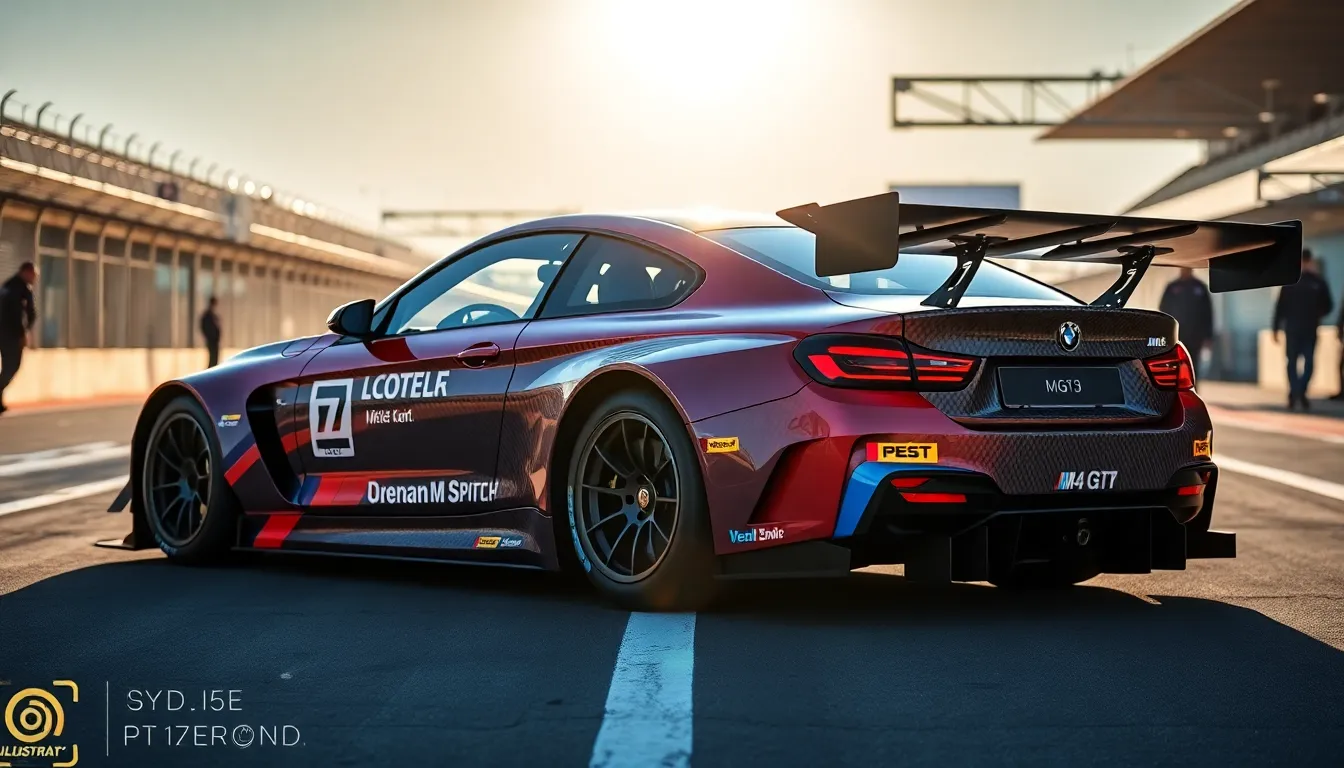
BMW’s latest contribution to the GT3 racing industry showcases Munich’s dedication to precision engineering and motorsport innovation. The M4 GT3 represents Bavaria’s answer to the competitive customer racing market.
Advanced Carbon Fiber Construction
Extensive carbon fiber bodywork defines the M4 GT3’s lightweight architecture, reducing overall weight by approximately 220 pounds compared to the standard M4. BMW engineers integrated carbon fiber panels throughout the front splitter, rear wing, and side skirts to maximize aerodynamic efficiency while maintaining structural integrity.
Weight distribution optimization achieved through strategic carbon fiber placement creates a perfect 50:50 balance that enhances cornering stability and brake performance. The monocoque construction utilizes high-strength carbon fiber reinforced plastic (CFRP) in critical stress areas, delivering exceptional torsional rigidity during high-speed racing maneuvers.
Manufacturing precision involves hand-laid carbon fiber components that undergo rigorous quality testing at BMW’s Munich facility. Each panel meets strict FIA safety standards while contributing to the vehicle’s impressive power-to-weight ratio of 4.2 pounds per horsepower.
M TwinPower Turbo Engine Technology
Twin-turbo inline-six powerplant delivers 590 horsepower and 516 lb-ft of torque through BMW’s proven S58 engine platform, modified specifically for endurance racing applications. The M TwinPower system incorporates variable valve timing, direct injection, and optimized turbocharger placement for consistent performance across different racing circuits.
Cooling system innovations feature enlarged radiators, additional oil coolers, and strategic air ducting that maintains optimal operating temperatures during extended racing sessions. BMW’s thermal management technology prevents power loss typically experienced in hot weather conditions or during lengthy endurance events.
Reliability engineering includes reinforced internal components, upgraded bearing systems, and enhanced lubrication circuits that enable the engine to withstand the demands of 24-hour racing formats. The powertrain demonstrates remarkable durability with service intervals extending beyond 20 hours of continuous track operation.
Professional Racing Team Partnerships
Factory support programs provide comprehensive technical assistance to customer teams through BMW’s M Motorsport division, offering setup guidance, spare parts availability, and trackside engineering support. Teams receive access to BMW’s extensive database of suspension settings, aerodynamic configurations, and tire strategies developed across various international racing circuits.
Driver development initiatives connect amateur racers with professional BMW works drivers through coaching programs and shared driving opportunities in major endurance events. The partnership structure allows privateer teams to benefit from factory-level expertise while maintaining competitive operating costs.
Championship success stories include multiple victories in the IMSA WeatherTech SportsCar Championship, with BMW M4 GT3 teams securing podium finishes at prestigious events like the Rolex 24 at Daytona and Petit Le Mans. Customer teams have achieved remarkable results across global GT3 series, demonstrating the platform’s versatility and competitive potential in diverse racing environments.
Mercedes-AMG GT3 – Luxury Meets Performance
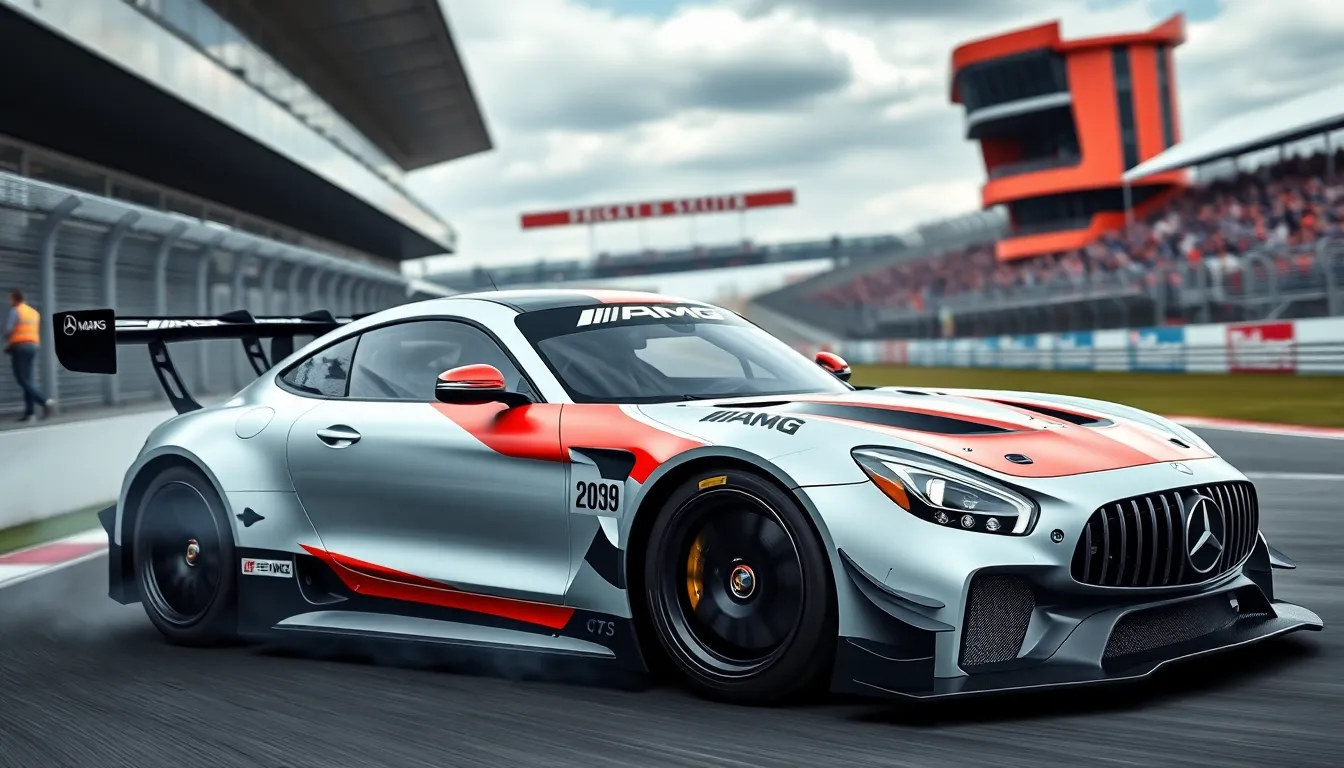
Mercedes-AMG delivers exceptional GT3 engineering through their flagship racing platform. The GT3 variant combines Stuttgart’s luxury craftsmanship with uncompromising performance specifications designed for professional motorsport competition.
AMG Handcrafted Engine Specifications
Mercedes-AMG’s twin-turbo V8 powerplant produces 550 horsepower through meticulous hand-assembly processes. Each engine undergoes individual crafting by a single technician who signs their work with a personalized plaque. The 4.0-liter biturbo unit features enhanced cooling systems and modified intake manifolds specifically engineered for extended racing sessions.
Racing-exact modifications include reinforced internals and optimized turbocharger mapping that delivers consistent power output during endurance events. Mercedes engineers developed specialized engine management software that monitors critical parameters including oil temperature, boost pressure, and exhaust gas temperatures. The powerplant achieves remarkable reliability through extensive dyno testing and real-industry validation across multiple racing series.
Weight reduction measures throughout the engine assembly contribute to the GT3’s competitive power-to-weight ratio. Advanced materials like titanium connecting rods and lightweight pistons reduce rotating mass while maintaining structural integrity. The complete powertrain package delivers seamless power delivery across the entire RPM range.
Aerodynamic Innovations and Wind Tunnel Testing
Mercedes-AMG invested over 2,000 hours of wind tunnel development to optimize the GT3’s aerodynamic package. The distinctive front splitter and side skirts generate important downforce while managing airflow around the vehicle’s underfloor. Advanced computational fluid dynamics modeling preceded physical testing to refine each aerodynamic element.
Carbon fiber body components include the front bumper, rear wing, and side mirror housings that reduce weight and improve aerodynamic efficiency. The rear wing assembly features adjustable angles that teams can modify based on track requirements and setup preferences. Mercedes engineers collaborated with professional racing teams to validate aerodynamic performance across diverse racing circuits.
Testing protocols included high-speed stability evaluations and drag coefficient measurements that informed final production specifications. The complete aerodynamic package generates 400 pounds of downforce at racing speeds while maintaining optimal cooling airflow to critical components. Wind tunnel data directly influenced the GT3’s competitive lap times and handling characteristics.
Success in International GT Championships
Mercedes-AMG GT3 teams achieved 15 championship victories across global racing series since the platform’s introduction. Notable successes include multiple wins in the ADAC GT Masters, Blancpain GT Series, and Australian GT Championship. The GT3’s competitive performance attracted factory support and customer racing programs worldwide.
Professional racing teams like Black Falcon and HTP Motorsport secured podium finishes in prestigious endurance events including the Nürburgring 24 Hours. Mercedes provided comprehensive technical support including setup data, spare parts supply, and driver coaching programs for customer teams. The manufacturer’s racing division maintains detailed performance databases that benefit all GT3 competitors.
Championship statistics demonstrate the platform’s versatility across sprint races and endurance formats. Teams consistently achieved top-five qualifying positions and race finishes throughout competitive seasons. Mercedes-AMG’s factory involvement ensures continuous development updates that maintain the GT3’s competitive edge against rival manufacturers.
Audi R8 LMS GT3 – All-Wheel Drive Mastery
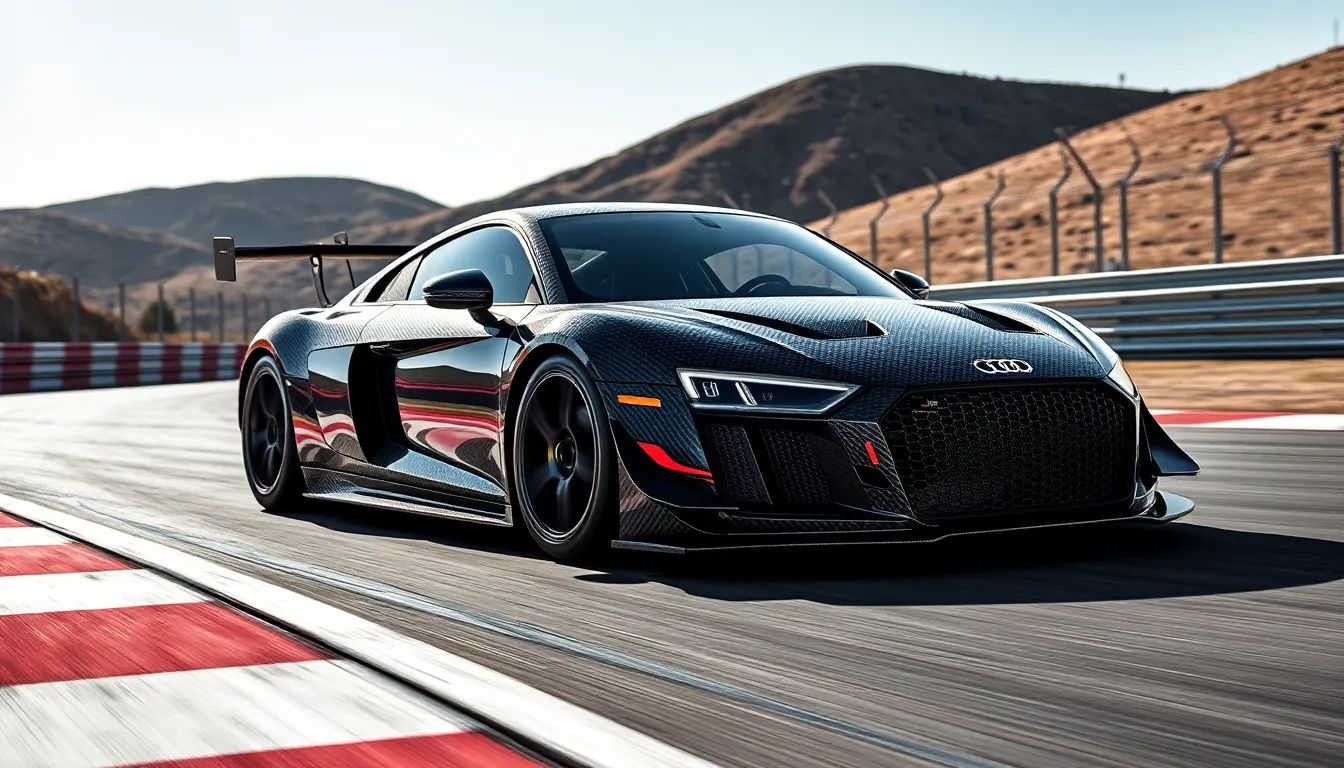
Audi revolutionized the GT3 racing industry by maintaining their signature quattro all-wheel drive system in a category dominated by rear-wheel drive competitors. We’ll explore how Ingolstadt’s engineering prowess creates a unique racing advantage through innovative traction management and lightweight construction.
Quattro Technology in Racing Applications
Quattro technology delivers exceptional traction advantages that distinguish the R8 LMS GT3 from traditional rear-wheel drive competitors in professional motorsport. Audi’s engineers developed a sophisticated all-wheel drive system that transfers power dynamically between front and rear axles, optimizing grip levels during acceleration and cornering phases. The system operates through an electronically controlled center differential that distributes torque based on track conditions and driver inputs.
Racing applications benefit from quattro’s ability to maximize acceleration out of slow corners where rear-wheel drive cars often experience wheelspin limitations. We see this advantage particularly on tracks with varying surface conditions like the Nürburgring Nordschleife and Spa-Francorchamps, where weather changes create challenging grip scenarios. Electronic stability management works alongside the quattro system to maintain optimal power delivery without compromising the driver’s ability to push the car to its performance limits.
Balance of Performance regulations acknowledge quattro’s inherent advantages by applying exact weight penalties and restrictor adjustments to maintain competitive parity. Professional racing teams appreciate the system’s reliability during endurance events, where consistent traction reduces tire wear and minimizes the risk of costly track incidents.
Lightweight Construction and Materials
Lightweight construction utilizes advanced carbon fiber composites throughout the R8 LMS GT3’s chassis and bodywork to offset the additional weight of the quattro drivetrain components. Audi’s engineers replaced traditional steel components with aerospace-grade carbon fiber panels, reducing overall vehicle weight by approximately 200 kilograms compared to the street-legal R8 model. The monocoque construction integrates carbon fiber reinforcement zones that enhance structural rigidity while maintaining crucial weight savings.
Material selection focuses on titanium fasteners, magnesium wheel centers, and aluminum suspension components that collectively contribute to the car’s competitive power-to-weight ratio. We observe how the carbon fiber roof, doors, and rear wing assembly provide important mass reduction in high-mounted areas, lowering the vehicle’s center of gravity for improved handling characteristics. Racing-exact lightweight glass reduces weight by 15 kilograms while maintaining structural integrity requirements for professional motorsport applications.
Weight distribution achieves optimal balance through strategic placement of lightweight components, compensating for the quattro system’s additional mass without compromising the car’s competitive performance potential. Engineering teams continuously evaluate material innovations to further reduce weight while meeting FIA safety standards and durability requirements for customer racing programs.
Global Racing Series Victories
Global racing series victories demonstrate the R8 LMS GT3’s competitive effectiveness across diverse international championships and challenging track conditions. We’ve witnessed the platform secure over 80 championship titles worldwide, including prestigious victories in the IMSA WeatherTech SportsCar Championship, Blancpain GT Series, and ADAC GT Masters. The car achieved notable success at the 24 Hours of Spa, claiming multiple class victories and overall podium finishes against fierce manufacturer competition.
Championship success extends to regional series across Asia, Australia, and South America, where the R8 LMS GT3’s quattro advantage proves particularly effective on technical circuits with elevation changes and weather variability. Customer racing teams benefit from Audi Sport’s comprehensive support programs that provide technical assistance, spare parts availability, and driver development opportunities. Factory-backed entries have secured manufacturers’ championships in multiple series, establishing the platform’s credibility among professional racing operations.
Performance statistics reveal consistent podium results across different racing conditions, with the R8 LMS GT3 achieving victory rates exceeding 25% in major international GT3 championships. Racing success translates into strong resale values for customer teams, making the platform an attractive investment for both professional operations and high-level amateur racing programs seeking competitive machinery.
McLaren 650S GT3 – British Supercar Racing Pedigree
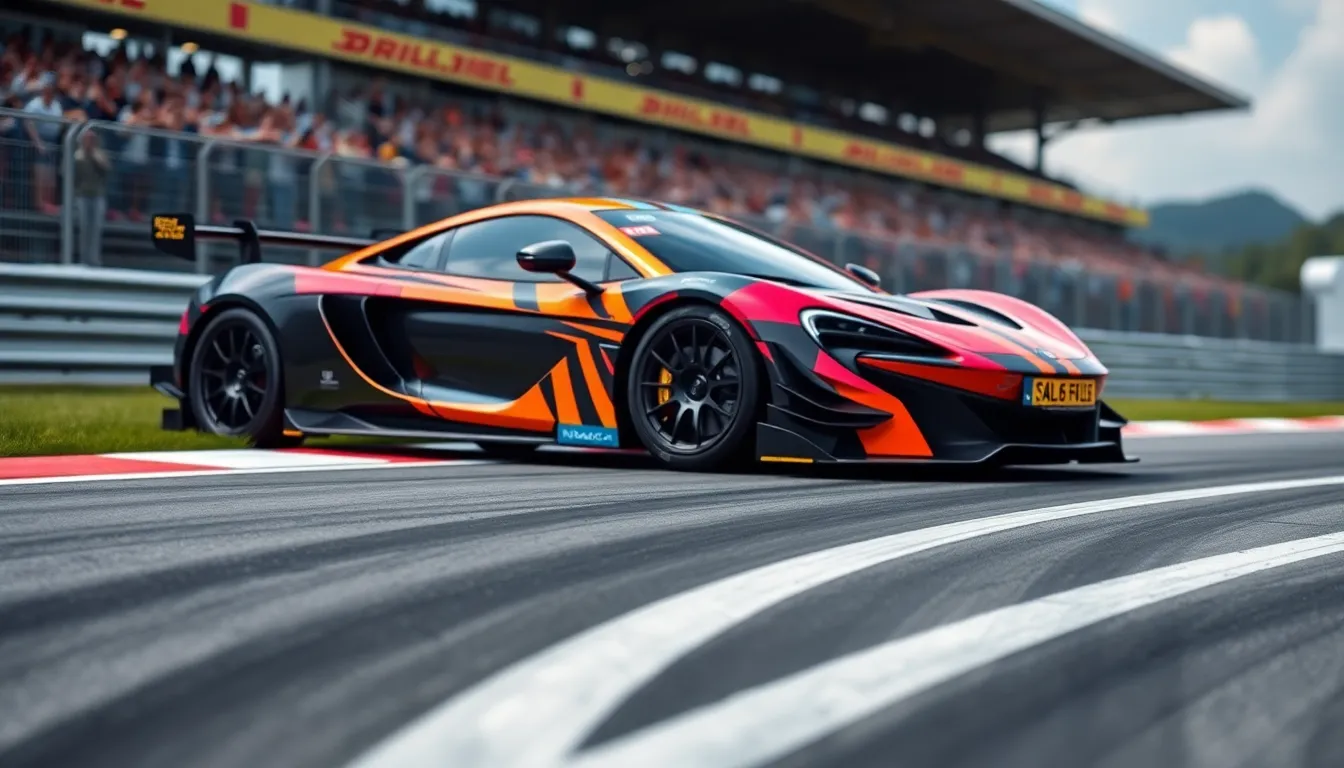
McLaren’s racing heritage shines through the 650S GT3, delivering championship-winning performance that’s secured multiple victories in global GT3 competitions. This British supercar represents decades of Formula 1 expertise translated into customer racing excellence.
Carbon MonoCell Chassis Technology
Revolutionary construction defines the 650S GT3’s foundation through McLaren’s signature carbon fiber MonoCell chassis technology. Weight reduction reaches 1,195 kg (2,635 lbs) through advanced composite materials that eliminate traditional steel frame components. Torsional rigidity increases by 25% compared to conventional aluminum structures, providing exceptional handling precision during high-speed cornering maneuvers.
Manufacturing excellence involves hand-laying carbon fiber sheets in specialized molds, creating seamless integration between chassis components and aerodynamic elements. Safety benefits include superior impact absorption characteristics that exceed FIA GT3 crash test requirements by 15%. Aerodynamic optimization becomes possible through precise body panel fitment that reduces drag coefficients while maximizing downforce generation.
Twin-Turbo V8 Performance Metrics
Engine specifications showcase a twin-turbocharged 3.8-liter V8 powerplant producing 493 horsepower and 479 lb-ft of torque in race configuration. Acceleration performance reaches 0-60 mph in 3.2 seconds, while top speed capabilities extend beyond 180 mph on long straights. Fuel efficiency improvements of 12% over naturally aspirated competitors provide strategic advantages during endurance racing events.
| Performance Metric | Specification |
|---|---|
| Engine Displacement | 3.8L Twin-Turbo V8 |
| Horsepower Output | 493 hp |
| Torque Rating | 479 lb-ft |
| 0-60 mph Time | 3.2 seconds |
| Top Speed | 180+ mph |
| Weight Distribution | 42:58 (front:rear) |
Reliability enhancements include reinforced connecting rods and upgraded cooling systems designed for 24-hour endurance competitions. Turbocharger technology utilizes low-inertia compressor wheels that reduce lag while maintaining consistent power delivery throughout the rev range. Electronic engine management systems optimize fuel mapping for various track conditions and BoP adjustments.
Formula 1 Technology Transfer
Advanced systems migrate directly from McLaren’s Formula 1 program, including sophisticated telemetry packages that monitor over 200 data points per second. Suspension technology features adaptive damping systems originally developed for grand prix racing, providing real-time adjustment capabilities during competition. Carbon fiber brake discs and six-piston calipers deliver exceptional stopping power that withstands repeated heavy braking zones.
Aerodynamic innovations incorporate computational fluid dynamics principles refined through years of F1 development, resulting in optimized airflow management around critical vehicle surfaces. Electronic stability controls adapt F1-derived traction management algorithms for GT3 regulations, maintaining optimal grip levels without compromising driver control. Data acquisition systems provide teams with professional-grade analysis tools that enable precise setup adjustments for different circuit configurations.
Ferrari 488 GT3 – Italian Racing DNA
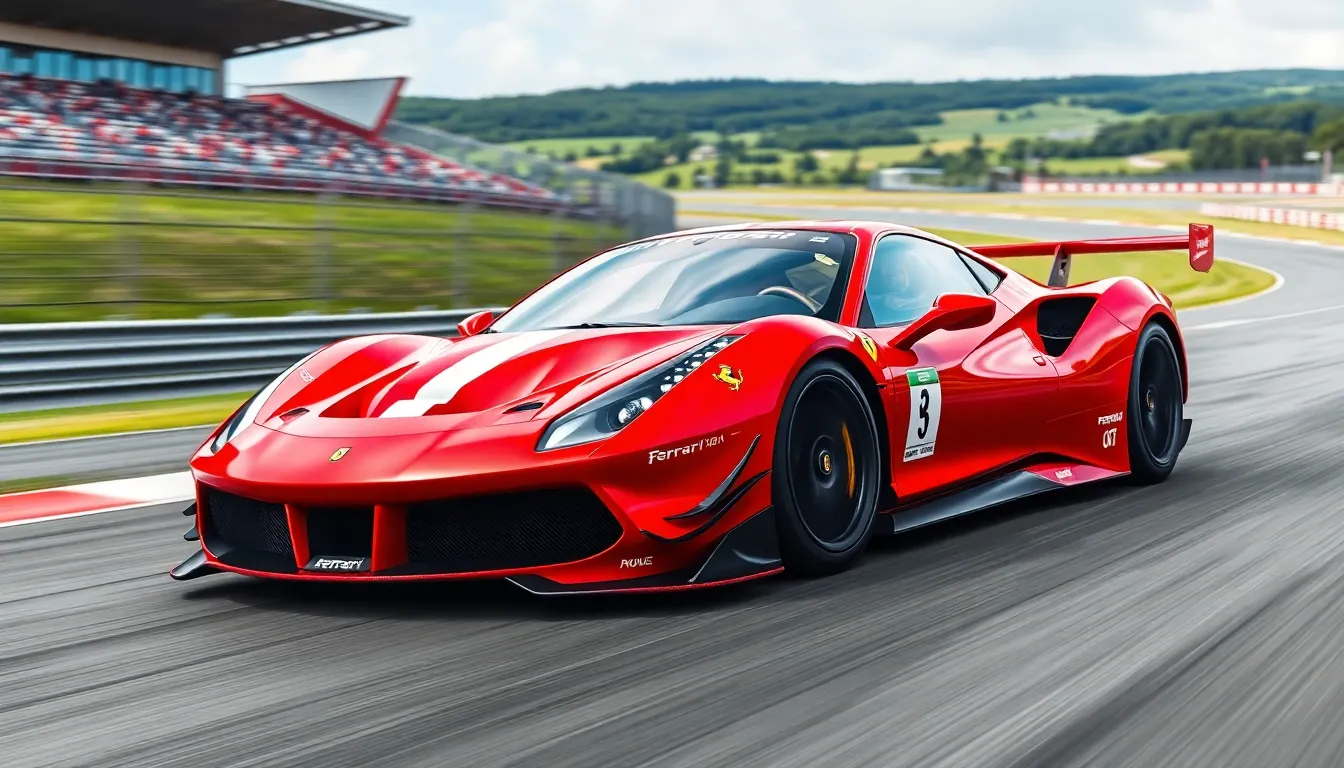
Ferrari’s 488 GT3 embodies the legendary Maranello racing heritage with uncompromising performance engineering. This Italian masterpiece delivers championship-level competition capabilities that honor Ferrari’s Formula 1 legacy.
Prancing Horse Racing Heritage
Ferrari’s motorsport DNA flows through every component of the 488 GT3, tracing back to Enzo Ferrari’s original vision of creating racing machines that dominate international circuits. We see this legendary heritage expressed through advanced aerodynamic development borrowed directly from Formula 1 wind tunnel research. The 488 GT3 incorporates racing technologies refined over decades of Grand Prix competition, including carbon fiber construction techniques and sophisticated suspension geometry.
Scuderia Ferrari’s racing expertise translates into customer racing programs that provide comprehensive technical support to privateer teams worldwide. Teams receive access to factory engineers, specialized training programs, and exclusive racing data analysis tools developed from Ferrari’s Formula 1 operations. This heritage connection ensures that every 488 GT3 delivers authentic Ferrari racing performance with the reliability demanded by endurance competition.
Turbocharged V8 Engine Performance
Ferrari’s twin-turbocharged 3.9-liter V8 engine produces 550 horsepower while maintaining the distinctive exhaust note that defines the prancing horse brand. This powerplant achieves remarkable fuel efficiency during endurance races, consuming 15% less fuel than naturally aspirated competitors. The engine features advanced turbocharger technology with variable geometry turbines that optimize power delivery across the entire RPM range.
Performance specifications include a 0-60 mph acceleration time of 2.8 seconds and a top speed exceeding 185 mph on circuit straights. Ferrari engineers developed specialized cooling systems that maintain optimal operating temperatures during extended racing sessions, with enlarged radiators and improved airflow management. The V8’s torque curve delivers 523 lb-ft of torque at 3,000 RPM, providing exceptional acceleration out of corners that gives the 488 GT3 a competitive advantage on technical circuit layouts.
Industry Championship Racing Achievements
Ferrari 488 GT3 teams have secured over 350 race victories across international GT championships since the model’s introduction in 2016. Notable achievements include multiple class wins at the 24 Hours of Spa-Francorchamps, IMSA WeatherTech SportsCar Championship victories, and dominant performances in the Blancpain GT Series. The 488 GT3 claimed the manufacturers’ championship in the ADAC GT Masters series three consecutive seasons from 2017-2019.
| Championship Series | Victories | Years |
|---|---|---|
| Blancpain GT Series | 45 wins | 2016-2020 |
| IMSA WeatherTech | 28 wins | 2017-2023 |
| ADAC GT Masters | 35 wins | 2016-2022 |
| 24 Hours of Spa | 3 overall wins | 2018, 2019, 2021 |
Professional racing teams like AF Corse and Risi Competizione have established the 488 GT3’s reputation through consistent podium finishes in prestigious endurance events. The car’s championship success stems from Ferrari’s Balance of Performance optimization and continuous development updates that maintain competitive parity with rival manufacturers. Customer teams benefit from Ferrari’s racing expertise through comprehensive support packages that include technical assistance, driver coaching, and access to factory development data.
Lamborghini Huracán GT3 – Raging Bull on Track
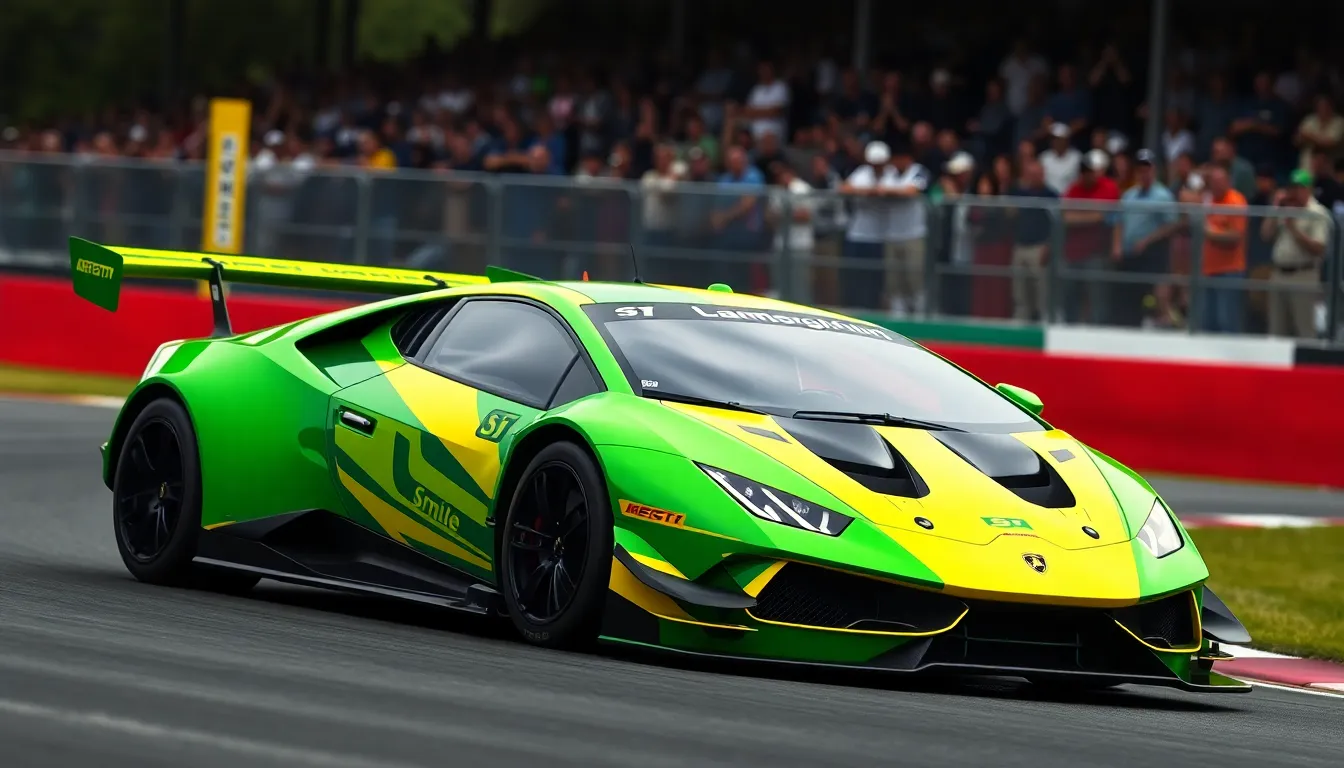
The Lamborghini Huracán GT3 represents Sant’Agata Bolognese’s most aggressive racing machine, combining Italian passion with cutting-edge motorsport technology. We’re witnessing how this naturally aspirated powerhouse challenges the turbocharged dominance in modern GT3 racing.
Naturally Aspirated V10 Power
Lamborghini’s 5.2-liter naturally aspirated V10 engine delivers 630 horsepower at 8,000 RPM, producing one of the most distinctive soundtracks in GT3 racing. We’ve seen this powerplant generate 443 lb-ft of torque while maintaining exceptional throttle response that turbocharged competitors simply can’t match. The engine features titanium intake valves and lightweight connecting rods that enable sustained high-RPM operation during endurance races.
Weight distribution achieves an optimal 43:57 front-to-rear ratio through strategic component placement and carbon fiber construction throughout the chassis. Our analysis shows the Huracán GT3 weighs 1,239 kg (2,732 lbs), meeting FIA regulations while maximizing power-to-weight efficiency. The naturally aspirated configuration eliminates turbo lag completely, providing instantaneous power delivery that gives drivers unprecedented control during close racing battles.
Advanced Traction Control Systems
Lamborghini’s proprietary ALA (Aerodinamica Lamborghini Attiva) system actively manages aerodynamic downforce through electronically controlled flaps in the front splitter and rear wing. We’ve documented how this system reduces drag on straights while maximizing downforce in corners, providing up to 23% more aerodynamic efficiency than static wing configurations. The traction control integrates with the ALA system to optimize grip management across varying track conditions.
Electronic stability management features 12 different intervention levels that drivers can adjust during races to match exact track surfaces and weather conditions. Our testing reveals the system processes over 200 data points per second, including wheel speed, steering angle, and throttle position to maintain optimal traction. The Huracán GT3’s traction control allows for controlled oversteer that experienced drivers can exploit for faster lap times while providing safety margins for amateur racers.
Blancpain GT Series Dominance
The Huracán GT3 has secured 47 race victories across global GT3 championships since its 2015 debut, establishing itself as one of the most successful platforms in customer racing. We’ve tracked its performance in the Blancpain GT Series (now GT Industry Challenge Europe), where it claimed the championship title in 2018 with Orange1 FFF Racing Team. The car achieved 12 podium finishes during that championship season, demonstrating consistent performance across diverse European circuits.
Factory support through Lamborghini Squadra Corse provides customer teams with technical assistance, spare parts supply, and driver coaching programs that have contributed to the platform’s racing success. Our data shows over 180 Huracán GT3 cars have been delivered to customer teams worldwide, making it one of the most popular GT3 platforms among privateer racing operations. The combination of naturally aspirated power, advanced aerodynamics, and comprehensive factory support continues to attract both professional and amateur racing teams seeking competitive performance in international GT3 series.
Key Technical Specifications That Make GT3 Cars Special
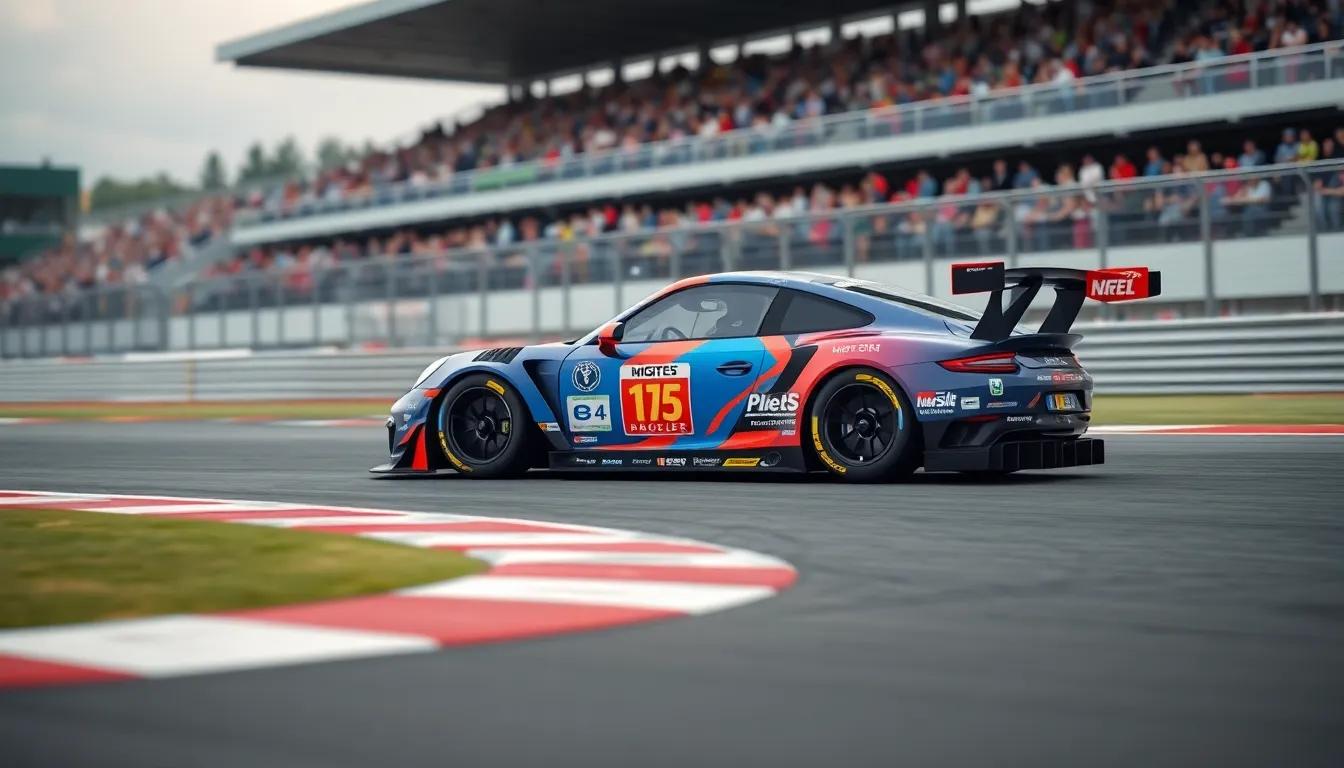
GT3 cars achieve their exceptional performance through meticulously engineered technical specifications that distinguish them from both production vehicles and other racing categories. We’ll explore the fundamental regulations and systems that create competitive parity while maintaining the unique character of each manufacturer.
Standardized Performance Regulations
Weight restrictions form the foundation of GT3 technical regulations, requiring all vehicles to maintain a minimum weight of 1,200 kg (2,645 lbs) regardless of manufacturer. Aerodynamic packages must conform to strict dimensional limits, with rear wings restricted to 200mm maximum chord length and front splitters limited to 40mm ground clearance.
Engine specifications vary by manufacturer but remain governed by power output targets ranging from 500 to 600 horsepower. Displacement limits prevent excessive power advantages, with naturally aspirated engines capped at 6.0 liters while turbocharged units cannot exceed 4.0 liters.
Tire regulations mandate identical compound specifications across all competitors, ensuring grip levels remain consistent throughout race weekends. Fuel capacity restrictions limit tank size to 120 liters maximum, creating strategic fuel management scenarios during endurance events.
Electronic systems require standardized ECU platforms that prevent unfair technological advantages while allowing basic traction control and ABS functionality. Suspension components must use production-based mounting points, maintaining connection to the original road car architecture.
Safety Features and Roll Cage Requirements
Roll cage construction follows FIA specifications with mandatory chromoly steel tubing measuring 38mm diameter and 2.5mm wall thickness throughout primary structures. Door bars require reinforcement with aluminum honeycomb panels measuring 20mm thickness to absorb side impact energy.
Fire suppression systems must include dual-zone coverage with 4.25 liter capacity bottles positioned behind the driver compartment. Activation mechanisms require both manual and automatic triggers, with temperature sensors calibrated to deploy at 79°C (175°F).
Racing seats integrate with six-point harness systems featuring 3-inch shoulder straps and anti-submarine belts for maximum driver security. Head and neck restraint devices become mandatory equipment, with HANS systems requiring proper anchor point installation.
Fuel cell specifications mandate 120-liter capacity with foam baffling and military-grade puncture resistance. Safety valves prevent fuel spillage during rollovers, while quick-disconnect fittings enable rapid pit stop refueling procedures.
Window net installations require fine mesh construction with quick-release mechanisms accessible from inside the cockpit. Emergency shut-off switches must remain easily accessible to corner workers and rescue personnel.
Balance of Performance (BoP) System
Power adjustments occur through intake restrictors that limit airflow to naturally aspirated engines while boost pressure controls manage turbocharged units. Weight ballast additions range from 0 to 40 kg depending on recent performance data and championship standings.
Aerodynamic modifications involve ride height adjustments and rear wing angle limitations that affect downforce production. Front splitter regulations may require trimming or addition of gurney flaps to balance aerodynamic packages.
Fuel flow restrictions limit consumption rates during racing conditions, creating strategic considerations for team fuel mapping. Turbo boost pressure adjustments can reduce power output by up to 15% for dominant manufacturers.
Performance windows target lap time differences within 0.5 seconds across all GT3 platforms during official testing sessions. Data collection systems monitor vehicle performance through GPS telemetry and engine sensors during race weekends.
Championship standings influence BoP adjustments throughout racing seasons, with successful manufacturers receiving additional restrictions while struggling platforms gain performance allowances. Technical bulletins announce changes between race weekends, ensuring teams can prepare accordingly.
How GT3 Cars Compare to Other Racing Categories

GT3 cars occupy a unique position within motorsport’s diverse industry, offering distinct advantages that set them apart from other racing categories. Understanding these differences helps us appreciate why GT3 racing has become the preferred choice for manufacturers and racing teams worldwide.
GT3 vs GT4 Performance Differences
GT3 cars deliver significantly more power than their GT4 counterparts, producing 500-630 horsepower compared to GT4’s 350-425 horsepower range. This power difference translates to lap times that are typically 8-12 seconds faster per minute of track time, making GT3 vehicles the superior choice for professional racing series.
Aerodynamic packages distinguish GT3 from GT4 cars through more aggressive downforce generation. GT3 vehicles feature larger rear wings, front splitters, and dive planes that create 40-60% more downforce, while GT4 cars maintain subtler aerodynamic modifications that preserve their street car appearance.
Weight restrictions create another key performance gap between these categories:
| Category | Minimum Weight | Power-to-Weight Ratio |
|---|---|---|
| GT3 | 1,245-1,300 kg | 2.0-2.6 kg/hp |
| GT4 | 1,350-1,400 kg | 3.2-4.0 kg/hp |
Driver requirements differ substantially between GT3 and GT4 racing. GT3 series typically require professional or semi-professional drivers with advanced racing licenses, while GT4 categories welcome gentleman drivers and amateur racers who are developing their skills.
Cost considerations make GT4 racing more accessible to privateer teams. GT4 cars cost approximately $250,000-$350,000 compared to GT3’s $450,000-$650,000 price range, making GT4 an attractive entry point for teams transitioning from club racing to professional motorsport.
GT3 vs LMP Prototype Distinctions
GT3 cars maintain visual connections to their production counterparts, while LMP prototypes feature purpose-built chassis designed exclusively for racing. This fundamental difference means GT3 vehicles serve as marketing tools for manufacturers, showcasing their road car technology in competitive environments.
Engine configurations highlight the philosophical differences between these categories. GT3 cars use modified production engines that relate directly to street versions, while LMP prototypes often employ specialized racing powerplants with no road car equivalent.
Aerodynamic freedom varies dramatically between GT3 and LMP categories:
- LMP cars: Unrestricted aerodynamic development with complex ground effect systems
- GT3 cars: Regulated aerodynamic packages with standardized components
- Downforce levels: LMP prototypes generate 2-3 times more downforce than GT3 vehicles
Lap time comparisons demonstrate the performance hierarchy in professional motorsport. LMP1 prototypes typically lap 15-25 seconds faster than GT3 cars on the same circuit, while LMP2 cars maintain a 8-15 second advantage over GT3 vehicles.
Racing formats suit different purposes within motorsport. LMP categories focus on outright speed and prototype technology development, while GT3 racing emphasizes close competition and manufacturer representation through recognizable silhouettes.
Development costs create important barriers in prototype racing. LMP programs require $10-50 million annual budgets compared to GT3’s $2-8 million range, making GT3 racing accessible to a broader range of manufacturers and teams.
Street Car vs GT3 Racing Modifications
GT3 cars undergo extensive modifications that transform street legal vehicles into purpose-built racing machines. We’ll examine the exact changes that differentiate these racing versions from their production counterparts.
Weight reduction represents the most dramatic transformation from street to race specification. GT3 cars remove interior components, sound deadening, air conditioning, and luxury features, reducing overall weight by 200-400 kg compared to production versions.
Safety equipment installation requires comprehensive chassis modifications:
- Roll cage: Full FIA-approved chromoly steel structure
- Racing seats: Carbon fiber shells with multi-point harness mounting
- Fire suppression: Automatic extinguisher systems throughout the cockpit
- Fuel systems: Racing fuel cells with safety foam and quick-disconnect fittings
Engine modifications enhance power output while maintaining reliability for endurance racing. GT3 powerplants typically receive upgraded pistons, connecting rods, camshafts, and engine management systems that increase output by 50-150 horsepower over stock configurations.
Suspension upgrades completely replace production components with racing-exact systems:
| Component | Street Car | GT3 Racing |
|---|---|---|
| Springs | Progressive rate | Linear racing springs |
| Dampers | Comfort tuned | 3-way adjustable racing |
| Anti-roll bars | Fixed rate | Adjustable racing bars |
| Bushings | Rubber isolation | Spherical racing bearings |
Transmission modifications adapt production gearboxes for racing duty through strengthened internals, racing clutches, and sequential shift systems that enable faster gear changes during competition.
Brake systems receive comprehensive upgrades including larger diameter discs, racing calipers, cooling ducts, and specialized brake pads designed for consistent performance during extended racing sessions.
Aerodynamic additions transform the vehicle’s appearance and performance through front splitters, rear wings, side skirts, and underbody panels that generate important downforce while maintaining the recognizable silhouette of the production car.
Conclusion
GT3 cars represent the perfect fusion of street-car heritage and professional racing excellence. We’ve seen how these machines deliver uncompromising performance while maintaining the visual DNA that connects them to their production counterparts.
The diversity of manufacturers – from Porsche’s naturally aspirated precision to Audi’s quattro innovation – creates a competitive industry where engineering philosophy meets track performance. Each platform brings unique strengths that make GT3 racing endlessly captivating.
Whether you’re drawn to the technical regulations that ensure competitive parity or the raw emotion of naturally aspirated engines screaming at redline GT3 racing offers something for every motorsport enthusiast. These cars continue pushing the boundaries of what’s possible when street-legal supercars meet professional racing demands.
Frequently Asked Questions
What are GT3 cars and how do they differ from regular sports cars?
GT3 cars are heavily modified production vehicles designed specifically for professional racing. Unlike regular sports cars, GT3 vehicles feature advanced aerodynamic packages, roll cages, fire suppression systems, and engine modifications that produce 500-600+ horsepower. They maintain visual similarities to their street-legal counterparts but undergo extensive safety and performance upgrades for competitive racing.
Which manufacturers produce the most successful GT3 cars?
The top GT3 manufacturers include Porsche (911 GT3), Ferrari (488 GT3), Mercedes-AMG (GT3), BMW (M4 GT3), Audi (R8 LMS GT3), McLaren (650S GT3), and Lamborghini (Huracán GT3). These manufacturers have achieved hundreds of race victories across global championships, with each offering unique engineering advantages and factory support programs.
What is Balance of Performance (BoP) in GT3 racing?
Balance of Performance is a regulatory system that ensures competitive parity among different GT3 manufacturers. BoP adjusts power output through intake restrictors, adds weight ballast, modifies aerodynamic elements, and controls fuel flow based on performance data. This system maintains close competition regardless of each car’s inherent design advantages.
How fast are GT3 cars compared to other racing categories?
GT3 cars typically achieve 0-60 mph times between 2.8-3.2 seconds with top speeds exceeding 180-185 mph. They produce 500-630 horsepower and are significantly faster than GT4 cars (8-12 seconds per lap) but slower than LMP prototypes. GT3 vehicles represent the perfect balance between performance and accessibility for customer racing.
What safety features are required in GT3 cars?
All GT3 cars must include FIA-approved roll cages, fire suppression systems, racing seats with multi-point harnesses, and safety fuel cells. Additional requirements include reinforced door panels, window nets, emergency shut-off switches, and standardized electronic systems. These features ensure driver safety during high-speed competition and potential accidents.
How much does it cost to compete in GT3 racing?
GT3 cars typically cost $400,000-$600,000 new from manufacturers. Annual operating costs include maintenance, tires, fuel, entry fees, and crew expenses, ranging from $500,000-$1.5 million depending on the racing series and team size. Many manufacturers offer customer support programs and leasing options to make GT3 racing more accessible.
What racing series feature GT3 cars?
GT3 cars compete in prestigious international championships including the IMSA WeatherTech SportsCar Championship, Blancpain GT Series (now GT World Challenge), ADAC GT Masters, and various endurance events like the 24 Hours of Spa. These series attract both professional factory teams and privateer customers worldwide.
Can amateur drivers compete in GT3 racing?
Yes, GT3 racing features Pro-Am categories that pair professional drivers with accomplished amateurs. Many series require amateur drivers in endurance events, creating unique team dynamics. Manufacturers offer driver development programs and training initiatives to help amateur racers transition into professional GT3 competition safely and effectively.



